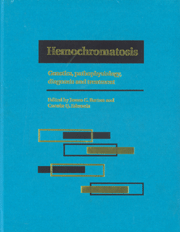Book contents
- Frontmatter
- Contents
- List of contributors
- Foreword
- Part I Introduction to hemochromatosis
- Part II Genetics of hemochromatosis
- Part III Metal absorption and metabolism in hemochromatosis
- Part IV Diagnostic techniques for iron overload
- Part V Complications of iron overload
- 21 Mechanisms of iron toxicity
- 22 Iron as a carcinogen
- 23 Clinical spectrum of hepatic disease in hemochromatosis
- 24 The arthropathy of hemochromatosis
- 25 Diabetes mellitus and hemochromatosis
- 26 Non-diabetic endocrinopathy in hemochromatosis
- 27 Cutaneous manifestations of hemochromatosis
- 28 Cardiac abnormalities in hemochromatosis
- 29 Estimate of the frequency of morbid complications of hemochromatosis
- 30 Juvenile hemochromatosis
- Part VI Therapy of hemochromatosis and iron overload
- Part VII Infections and immunity in hemochromatosis
- Part VIII Hemochromatosis heterozygotes
- Part IX Relationship of hemochromatosis to other disorders
- Part X Animal models of hemochromatosis and iron overload
- Part XI Screening for hemochromatosis
- Part XII Hemochromatosis: societal and ethical issues
- Part XIII Final issues
- Index
28 - Cardiac abnormalities in hemochromatosis
from Part V - Complications of iron overload
Published online by Cambridge University Press: 05 August 2011
- Frontmatter
- Contents
- List of contributors
- Foreword
- Part I Introduction to hemochromatosis
- Part II Genetics of hemochromatosis
- Part III Metal absorption and metabolism in hemochromatosis
- Part IV Diagnostic techniques for iron overload
- Part V Complications of iron overload
- 21 Mechanisms of iron toxicity
- 22 Iron as a carcinogen
- 23 Clinical spectrum of hepatic disease in hemochromatosis
- 24 The arthropathy of hemochromatosis
- 25 Diabetes mellitus and hemochromatosis
- 26 Non-diabetic endocrinopathy in hemochromatosis
- 27 Cutaneous manifestations of hemochromatosis
- 28 Cardiac abnormalities in hemochromatosis
- 29 Estimate of the frequency of morbid complications of hemochromatosis
- 30 Juvenile hemochromatosis
- Part VI Therapy of hemochromatosis and iron overload
- Part VII Infections and immunity in hemochromatosis
- Part VIII Hemochromatosis heterozygotes
- Part IX Relationship of hemochromatosis to other disorders
- Part X Animal models of hemochromatosis and iron overload
- Part XI Screening for hemochromatosis
- Part XII Hemochromatosis: societal and ethical issues
- Part XIII Final issues
- Index
Summary
Introduction
Hemochromatosis is a systemic disease that may involve nearly every organ of the body. Since the availability of insulin therapy for diabetes, congestive heart failure rather than diabetes is the leading cause of death in hemochromatosis. Patients who have hemochromatosis with cardiac involvement almost always have involvement in other organs, including the liver, joints, pancreas, spleen and pituitary gland. The severity of myocardial involvement varies widely and only roughly parallels that in other organs.
The cardiac complications of hemochromatosis usually develop late in the course of the disease, but a significant number of patients present initially with cardiovascular complications. Cardiac involvement usually leads to a mixed dilated/restrictive cardiomyopathic presentation with both systolic and diastolic dysfunction, often associated with arrhythmias. It is important for the care of the patient that the appropriate diagnosis be made and definitive treatment be promptly started.
The purpose of this chapter is to review the pathogenesis, pathophysiology, clinical features, diagnostic approaches, treatment and prevention of the cardiovascular complications of hemochromatosis.
Pathogenesis
In hemochromatosis the localization of iron in different tissues is determined by a combination of factors including the stage of the disease, the total amount of iron overload and the genetic susceptibility of certain organs to accumulate iron. Excessive tissue iron can be stored in the reticuloendothelial system until a threshold level is exceeded. When this happens, other solid organs including the liver, heart, pancreas, spleen and pituitary gland, can also act as storage sites for the excessive iron. Animal model studies suggest that the source of excessive iron may partially determine the degree of cardiac iron deposition. Iron from transfusional sources is more likely than ingested iron to accumulate in the heart.
- Type
- Chapter
- Information
- HemochromatosisGenetics, Pathophysiology, Diagnosis and Treatment, pp. 297 - 311Publisher: Cambridge University PressPrint publication year: 2000
- 10
- Cited by



